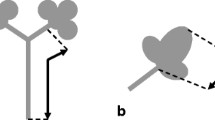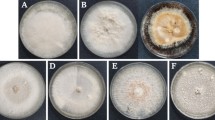Summary
An interaction betweenP. infestans andE. carotovora subsp.atroseptica (Eca) in rotting tubers was confirmed and the biochemical basis for its occurrence investigated. The pH of tissue infected withP. foveata became alkaline whereas tissue infected withP. infestans orF. coeruleum did not rise above neutrality, which could promote pathogenicity of Eca by maintaining pH closer to the optimum for polygalacturonase activity. Polygalacturonase, pectate lyase and galactanase were detected in cultures of all three fungi grown on media containing cell wall material or pectin from tubers. AsP. infestans produced more polygalacturonase than the other two fungal tuber rot pathogens the possibility was investigated that oligogalacturonide products of enzymatic degradation of pectin byP. infestans stimulates pathogenicity of Eca. However, while tubers soft-rotted after infiltration with supernatant from fungal cultures grown on tuber cell wall material, controls showed that rotting resulted from infiltration rather than the products contained in the infiltrated water.
Similar content being viewed by others
References
Bain, R.A., M.C.M. Pérombelon, M. Tsror & L. Machimas, 1990. Blackleg development and tuber yield in relation to numbers ofErwinia carotovora ssp.atroseptica on seed potatoes.Plant Pathology 39: 125–133.
Blodgett, E.C., 1947. Comments on black rot, a storage disease of potatoes in Idaho.Plant Disease Reporter 31: 10–13.
Collmer, A. & D.F. Bateman, 1982. Regulation of extracellular pectate lyase inErwinia chrysanthemi: evidence that reaction products of pectate lyase and exo-poly-a-D-galacturonosidase mediate induction on D-galacturonan.Physiological Plant Pathology 21: 127–139.
Collmer, A., P. Berman, & M.S. Mount, 1982. Pectate lyase regulation and bacterial soft rot pathogenisis. In: M.S. Mount & G.H. Lacy (Ed.), Phytopathogenic Prokaryotes, Academic Press, New York, pp. 395–422.
Collmer, A. & N.T. Keen, 1986. The role of pectic enzymes in plant pathogenesis.Annual Review of Phytopathology 24: 383–409.
Collmer, A., J.L. Reid & M.S. Mount, 1988. Assay methods for pectic enzymes. In:Methods in Enzymology, Academic Press, New York 161: 329–335.
Davis, J.R., L.H. Sorensen & G.S. Corsini, 1983. Interaction ofErwinia spp. andFusarium roseum ‘Sambucinum’ on the Russet Burbank potato.American Potato Journal 60: 409–421.
Henniger, H., 1963. Zur Kultur vonPhytophthora infestons auf vollsynthetischen Nährsubstraten.Zeitschrift für Allgemeine Mikrobiologie 3: 126–135.
Hossain, M. & C. Logan, 1983. A comparison of inoculum methods for determining potato cultivar reaction to blackleg.Annals of Applied Biology 103: 63–70.
Jarvis, M.C., D.R. Threlfall & J. Friend, 1981. Potato cell wall polysaccharides: Degradation with enzymes fromPhytophthora infestans.Journal of Experimental Botany 32: 1309–1319.
Logan, C. & R.B. Copeland, 1979. The effect of time of planting inoculated tubers on the incidence of blackleg and gangrene.Annals of Applied Biology 93: 133–140.
Munzert, M.von, J. Duben & E. Langerfeld, 1977. On the influence of fungal and bacterial tuber rot pathogens on emergence diseases in the potato crop.Nachrichtenbandes Deutschen Pfanzenschutzdienstes 29: 69–74.
Olsson, K., 1989. Relationship between pectolytic enzyme activity and rot development in potato tubers inoculated withFusarium solani var.coeruleum. Journal of Phytopathology 124: 225–235.
Pagel, W. & R. Heitefuss, 1990. Enzyme activities in soft rot pathogenesis of potato tubers: Effects of calcium, pH and degree of pectin esterification on the activities of polygalacturonase and pectate lyase.Physiological and Molecular Plant Pathology 37: 9–25.
Pérombelon, M.C.M. & A. Kelman, 1980. Ecology of the soft rot erwinias.Annual Review of Phytopathology 18: 361–387.
Protsenko, M.A., K.V. Vasil’eva, E.P. Ladyzhenskaya, T.A. Gladkikh, E.M. Glinka & G.L. Shaposhnikov, 1991. Study of interaction between extracellular metabolites ofPhytophthora infestans and cytoplasmic membranes from potato tubers.Prikladnaya Biokhimiya i Mikrobiologiya 27: 411–421.
Stanghellini, M.E. & J.D. Russell, 1971. Induction of bacterial seed piece decay of potatoes by various soil-borne fungi.Phytopathology 61: 1324.
Zink, R.T. & G.A. Secor, 1982. Interaction of fungi wilt pathogens and potato blackleg.Plant Disease 66: 1053–1056.
Author information
Authors and Affiliations
Rights and permissions
About this article
Cite this article
Sicilia, C., Copeland, R.B. & Cooke, L.R. Comparison of the interactions ofErwinia carotovora ssp.atroseptica withPhytophthora infestans, Phoma foveata andFusarium coeruleum in rotting potato tubers. Potato Res 45, 237–246 (2002). https://doi.org/10.1007/BF02736118
Accepted:
Issue Date:
DOI: https://doi.org/10.1007/BF02736118




